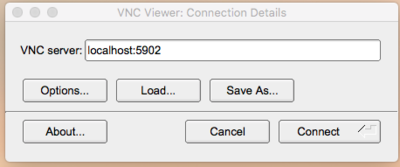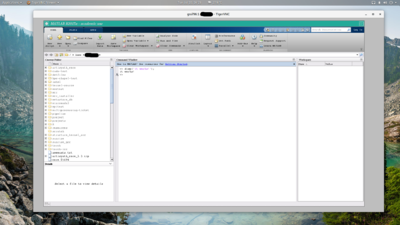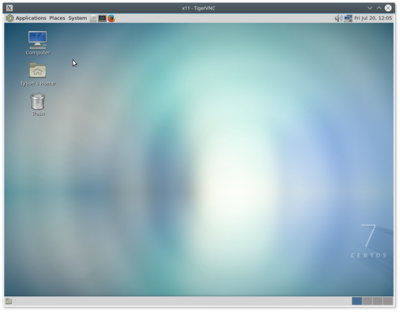VNC
It is often necessary to remotely start the graphical user interface for complex software packages such as MATLAB. The most common way to do this is with SSH and X11 forwarding. However the performance of SSH+X11 is often too slow similar to MobaXTerm or Putty. A much better alternative is to use VNC to connect to a remote desktop.
Setup
First you will need to install a VNC client on your machine to connect to the VNC server. We recommend using TigerVNC. A TigerVNC package is available for Windows, MacOS and most Linux distributions. The following shows how to download, install and configure TigerVNC securely for each operating system. The certificate configuration steps are only required for connecting to VDI nodes so the signing authority of the certificate presented by the vncserver is known. If a popup about a certificate issue occurs, either you have not configured it properly or you are not connected to our server and should not enter your password.
Windows
Download and run the latest stable vncviewer64-x.y.z.exe version package installer from the official download page ( for example vncviewer64-1.12.0.exe). Make sure you download the viewer and not the server. To create secure tunnels from your desktop to the vncserver as described in the sections below, you will need to open a terminal window and run the SSH command. This may be done using PowerShell standard on Windows 10 since the 1809 update.
MacOS
Install the latest stable DMG package by going to the official download page and click the green Download Latest Version button for TigerVNC-1.12.90.dmg (as of January 2023). Once the download is complete double click the DMG file to open it. A TigerVNC Viewer icon should appear in a popup window along with a LICENSE.TXT and README.rst file. To complete the installation, drag the tigervnc icon that appears into the Applications folder and/or the lower app dock. To remove the popup you will need to unmount the DMG file. To do this open a New Finder Window, verify View->ShowSidebar is selected, click the small up arrow beside TigerVNC-1.12.90 in the left side menu and lastly close the finder window. If you are running macOS Monterey 12.2 and TigerVNC crashes then you must upgrade to this latest version.
Linux
First install TigerVNC viewer with the package manager for your Linux version:
| Linux Version | Install Command |
|---|---|
| Debian, Ubuntu | sudo apt-get install tigervnc-viewer
|
| Fedora, CentOS, or RHEL | sudo yum install tigervnc
|
| Gentoo | emerge -av net-misc/tigervnc
|
Next, start TigerVNC by either finding it in the applications menu or running vncviewer on the command line. In the "VNC Viewer: Connection Details" window that appears click "Options -> Security" then tick all boxes except "Encryption None" and enter one of the following paths in the "Path to X509 CA Certificate" field.
| Linux Version | Path to X509 CA Certificate |
|---|---|
| Debian, Ubuntu | /etc/ssl/certs/ca-certificates.crt |
| Fedora, CentOS, or RHEL | /etc/pki/tls/certs/ca-bundle.crt |
| Gentoo | /etc/ssl/certs/ca-certificates.crt |
To save the settings click OK and then click Connect. If Connect is not clicked, the settings will not be saved.
Connect
Now you need a VNC server to connect to. This can be either a persistent vncserver running on dedicated VDI nodes which are part of Graham, or a temporary vncserver you start on a cluster compute node. VNC is not a heavyweight server, so you can certainly run lightweight sessions on cluster login nodes.
VDI nodes
Graham has dedicated VDI nodes collectively known as gra-vdi. These nodes provide a full graphical desktop, accelerated OpenGL, and shared access to Graham's /home, /project, and /scratch filesystems.
To connect, start your desktop VNC viewer (tigervnc) and input the address gra-vdi.computecanada.ca. This should bring up a login screen where you can enter your Alliance credentials and log in.
As with regular login nodes, the VDI nodes are a shared resource and not intended for doing batch computation (that is what the compute nodes are for) so please only use them for graphics-related tasks. For example graphical pre-processing such as mesh generation, graphical post-processing such as visualization, or graphical integrated development environments.
If you want to perform computational tasks within a GUI, please do so on a cluster compute node using the salloc command as described in the Compute Nodes section below. This will ensure the memory and CPU resources on gra-vdi are fully available for interactive graphical visualization purposes by other users when needed.
Login nodes
If you want to run a lightweight application in a remote VNC desktop (one that does not require much memory, cputime or a gpu) you may start a VNC server on a cluster login node and then connect to it with the following procedure:
[laptop:~] ssh graham.computecanada.ca
1) Specify a 1hr (3600 sec) time limit for your server (or more as required):
[gra-login2:~] vncserver -MaxConnectionTime 3600 Log file is /home/username/.vnc/gra-login2:3.log
2) Determine the listening port (5903 in this example):
[gra-login2:~] grep port /home/username/.vnc/gra-login2:3.log vncext: Listening for VNC connections on all interface(s), port 5903
[gra-login2:~] exit
3) Open a terminal window on your desktop and start a SSH tunnel to the VNC server:
[laptop:~] ssh graham.computecanada.ca -L 5901:gra-login2:5903
4) Open another terminal window on your desktop and connect with vncviewer:
[laptop:~] vncviewer localhost:5901
Mac or Windows users should click the TigerVNC Viewer application icon on their desktop and enter the localhost:port information in the "Connection Details" dialogue box that appears. Keep in mind that strict memory and cputime limits apply on cluster login nodes. On Graham, these are 8GB and 1 cpu-hour per process according to ulimit -t -v. If you require more resources, then run your VNC server on the VDI nodes or compute nodes instead as described above and below respectively.
Compute nodes
Where VDI login nodes are unavailable you can start a VNC server on a compute node, and with suitable port forwarding, connect to it from your desktop. This gives you dedicated access to the server, but does not provide a full graphical desktop or hardware-accelerated OpenGL.
1) Start a VNC server
Before starting your VNC server, log in to a cluster (such as Cedar) and create an allocation on a compute node using the salloc command (a 24hr maximum time limit applies). For example, to request an interactive job using 4 CPUs and 16GB of memory you could use the command:
[username@cedar5:~/project] salloc --time=1:00:00 --cpus-per-task=4 --mem=16000 --account=def-username
salloc: Pending job allocation 20067316
salloc: job 20067316 queued and waiting for resources
salloc: job 20067316 has been allocated resources
salloc: Granted job allocation 20067316
salloc: Waiting for resource configuration
salloc: Nodes cdr768 are ready for job
[username@cdr768:~/project]
Once your interactive job has started, one environment variable must be set in order to avoid some repetitive desktop errors:
[username@cdr768:~/project] export XDG_RUNTIME_DIR=${SLURM_TMPDIR}
Then, start a VNC server with vncserver. Take note of which node your job is running on. If unsure, you can use the hostname command to check. The first time you do this you will be prompted to set a password for your VNC server. DO NOT LEAVE THIS BLANK. You may change it later using the vncpasswd command. Continuing with the example:
[username@cdr768:~/project] vncserver
You will require a password to access your desktops.
Password:
Verify:
Would you like to enter a view-only password (y/n)? n
xauth: file /home/username/.Xauthority does not exist
New 'cdr768.int.cedar.computecanada.ca:1 (username)' desktop is cdr768.int.cedar.computecanada.ca:1
Creating default startup script /home/username/.vnc/xstartup
Creating default config /home/username/.vnc/config
Starting applications specified in /home/username/.vnc/xstartup
Log file is /home/username/.vnc/cdr768.int.cedar.computecanada.ca:1.log
Determine which port the VNC server is using by examining the log file:
[username@cdr768:~/project] grep port /home/username/.vnc/cdr768.int.cedar.computecanada.ca:1.log
vncext: Listening for VNC connections on all interface(s), port 5901
2) Set up a SSH tunnel to the VNC server
Once your VNC server has been started, create a "bridge" to allow your local desktop computer to connect to the compute node directly. This bridge connection is created using an SSH tunnel. SSH tunnels are created on your computer in a new local terminal window using the same SSH connection command as usual, with an extra option added which follows the format ssh user@host -L port:compute_node:port.
An example of an SSH tunnel command run on your computer to connect to a VNC server running on Cedar's cdr768 node and port 5901 would be the following:
[name@local_computer]$ ssh username@cedar.computecanada.ca -L 5902:cdr768:5901
The SSH tunnel operates like a normal SSH session: You may run commands over it, etc. However, keep in mind that this SSH session is also your connection to the VNC server. If you terminate the SSH session, your connection to the VNC server will be lost! For more information, please see SSH tunnelling.
3) Connect to the VNC server
If you have a Linux desktop, open a new local terminal window and tell your VNC client to connect to localhost:port. The following example uses the TigerVNC vncviewer command to connect to the running VNC server on cdr768. You will be prompted for the VNC password that you set up earlier in order to connect.
[name@local_computer]$ vncviewer localhost:5902
TigerVNC Viewer 64-bit v1.8.0
Built on: 2018-06-13 10:56
Copyright (C) 1999-2017 TigerVNC Team and many others (see README.txt)
See http://www.tigervnc.org for information on TigerVNC.
Tue Jul 10 17:40:24 2018
DecodeManager: Detected 8 CPU core(s)
DecodeManager: Creating 4 decoder thread(s)
CConn: connected to host localhost port 5902
CConnection: Server supports RFB protocol version 3.8
CConnection: Using RFB protocol version 3.8
CConnection: Choosing security type VeNCrypt(19)
CVeNCrypt: Choosing security type TLSVnc (258)
Tue Jul 10 17:40:27 2018
CConn: Using pixel format depth 24 (32bpp) little-endian rgb888
CConn: Using Tight encoding
CConn: Enabling continuous updates
If you are on a Mac or Windows desktop, click the TigerVNC Viewer application icon and enter the localhost:port information. For our example it becomes: 
Please note the port number in localhost:port specified above (5902) must match the local port (the first number) you specified when you set up the SSH tunnel. The default VNC port is 5900. If you specified 5900 for the local port of the SSH tunnel, you could omit it when you invoke vncviewer. However, Windows users may find that they cannot set up an SSH tunnel on local port 5900. Once connected, you will be presented with a Linux MATE desktop. To launch a terminal, click on the top menu on "Applications -> System Tools -> MATE Terminal". You may also add a shortcut to the top menu by right-clicking on "MATE Terminal" and by clicking on "Add this launcher to panel". Finally, to launch a program, invoke the command as you would normally within a bash session, for example xclock. To start a more complicated program like MATLAB, load the module and then run the matlab command.
More information
Vncserver password
To reset your VNC server password, use the vncpasswd command:
[gra-login1:~] vncpasswd
Password:
Verify:
Would you like to enter a view-only password (y/n)? n
Optionally you can completely remove your VNC configuration (including your password) by deleting your ~/.vnc directory. The next time you run vncserver you will be prompted to set a new password.
Killing vncserver
If a vncserver is no longer needed, terminate it with vncserver -kill :DISPLAY# as shown here:
[gra-login1:~] vncserver -list
TigerVNC server sessions:
X DISPLAY# PROCESS ID
:44 27644
[gra-login1:~] vncserver -kill :44
Killing Xvnc process ID 27644
If you have multiple vncservers running on a node, you may kill them all by running pkill Xvnc -u $USER.
Multiple connections
Any vncserver(s) running under your username can be listed with vncserver -list. To reconnect to a particular vncserver on a login node 1) re-establish a tunnel 2) run the vncviewer command again. It is possible to start multiple remote vncviewer connections to an existing vncviewer desktop, for example to open a second connection from your home machine while leaving the original vncviewer connection running at the office. To do this requires starting your vncserver with a special option vncserver -AlwaysShared, otherwise additional connections will by default close the initial connection to vncserver.
Failures to connect
Repeated failing attempts to establish a new vncserver/vncviewer connection may be due to an old SSH tunnel still running on your desktop tying up ports. To identify and kill any such tunnels, open a terminal window on your desktop and run ps ux | grep ssh followed by kill PID.
Unlock screensaver
If your VNC screensaver times out and requests a password, enter your cluster account password to unlock it (not your vncserver password). If you are running the MATE desktop and the screensaver will not unlock, try running killall -9 .mate-screensaver. This should no longer be a problem on our clusters as the VNC screensaver has been disabled.
Software
The VDI nodes have a special hardware and persistant virtual server configuration that support direct vncviewer connections and gpu accelerated OpenGL graphics for appropriately configured software applications. The VDI nodes also provide an extra layer of local software modules in addition to the standard global modules. These are made available by loading the SnEnv or StdEnv user environments respectively. On the clusters the StdEnv (and thus all modules in the global software stack) are loaded for you by default. On gra-vdi however when you login no environment or modules are loaded by default thus you will see:
[name@gra-vdi4]$ [user@gra-vdi3:~] module list
[name@gra-vdi4]$ No modules loaded
Therefore, before running any graphical software on gra-vdi you must first manually load one of following ...
CVMFS
Alliance software modules reside under /cvmfs and are available by default when you log into Graham, Cedar and Béluga. However, these modules are not loaded by default when you connect to gra-vdi over tigervnc. To load them, open a new terminal window on gra-vdi and run the following:
[name@gra-vdi4]$ module load CcEnv StdEnv/2020
[name@gra-vdi4]$ module avail
Alliance software modules will now be available on gra-vdi identical to the clusters. While these modules should always work reliably when running graphical applications on compute nodes, some may have stability issues running on gra-vdi such as sudden crashing or strange graphical artifacts including transparent windows or missing menus. To work around such problems, use an equivalent package from nix as described in the previous section; better graphics performance may also be realized. While the nix module provides a vast number of optimized/stable open-source packages for gra-vdi, it does not provide commercial module equivalents for ANSYS, COMSOL or StarCCM. These can be accessed by opening a new terminal window on gra-vdi and running:
[name@gra-vdi4]$ module load SnEnv
[name@gra-vdi4]$ module avail
NIX
The nix module on gra-vdi provides open-source software optimized to use accelerated OpenGL whenever possible. To load the nix module do:
[name@gra-vdi4]$ module load nix
The nix and nix-env commands are now in your path to install (and use) nix software packages within your personal nix environment.
o Installing software
To install a nix package into your environment, click the black terminal icon on the top menu bar or select Applications -> System Tools -> Terminal. Once a terminal window appears, run module load nix. You can now search for programs using the nix search <regexp> command and install them in your environment using the nix-env --install --attr <attribute> command. As an example, to install QGIS do the following:
[name@gra-vdi4]$ nix search qgis
[name@gra-vdi4]$ nix-env --install --attr nixpkgs.qgis
Your nix environment persists from one login to the next, so you only need to run an install command once. For example:
[name@gra-vdi4]$ module load nix
[name@gra-vdi4]$ qgis
works! In summary whatever software you install today will be available next time you load the nix module.
o Building OpenGL applications
For accelerated OpenGL to work, it is necessary to adjust compiled binaries to preload an appropriate version of the "vglfaker.so" library from VirtualGL. This has already been done for software modules available on gra-vdi and any OpenGL based packages you build/install via nix. It is, however, something that has to be done for any pre-built software you download or any codes you compile without using nix.
The easiest way to do this is to use the patchelf utility from nix (use nix-env --install --attr nixpkgs.patchelf to install it) to adjust the final binary. For example, if you built an OpenGL application against the system libraries and installed it as ~/.local/bin/myglapp, then you need to add the system VirtualGL library /usr/lib64/VirtualGL/libvglfaker.so as the first required library.
[name@gra-vdi4]$ module load nix
[name@gra-vdi4]$ patchelf --add-needed /usr/lib64/VirtualGL/libvglfaker.so ~/.local/bin/myglapp
Note that it is also possible to preload vglfaker.so via the LD_PRELOAD environment variable. This is generally a bad idea as it applies indiscriminately to all binaries, and those that require a different vglfaker.so than that set in LD_PRELOAD will then fail; however, it can be used safely in some cases in wrapper scripts.

